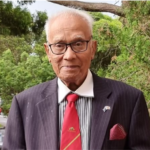Discovering ancient flush toilets in palatial residences in South Korea. – By Dr Harold Gunatillake

Showcasing the ingenuity of ancient civilisations.
Archaeologists Discover 1,300-Year-Old Multiple Flush Toilets at a Palace Complex in South Korea.
“The discovery of ancient flush toilets at The Donggung Palace complex in South Korea is regarded as a significant discovery, highlighting the advanced sanitation facilities available to the elite of the Silla Kingdom.
This is a fascinating topic: the discoveries of flushing toilets in ancient palaces. Let us delve deeper into this intriguing subject. I was inspired to create this video after reading an article by Sarah Kuta in Smithsonian magazine.
The discovery of 1,300-year-old flush toilets at the Donggung Palace complex in South Korea offers a glimpse into the advanced sanitation systems of the Unified Silla period.
These toilets, including one that drained directly into a nearby river, highlight the sophistication of royal facilities at the time.
Now what is the Silla period? The Silla Kingdom, one of the Three Kingdoms of Korea, existed from 57 BCE to 935 CE. Its capital was Seorabeol (modern-day Gyeongju). Silla unified the Korean peninsula in 668 CE, forming the Unified 0Silla Kingdom, which lasted until 935 CE, when the Goryeo Dynasty overthrew it.
The Donggung palace complex in present-day South Korea was once an elaborate lakeside retreat with at least 26 buildings used for hosting festivals and banquets. Archaeologists have also discovered several innovative “flush” toilets at the 1,300-year-old site, including one that likely drained into a nearby waterway.
Recent excavations at the complex have yielded significant discoveries. Researchers identified a quaint two-room structure, which includes a central aperture in a meticulously crafted granite slab. Adjacent to this aperture, they also uncovered a set of broad stepping stones, as the Korean Heritage Service reported, further enhancing the appeal of this intriguing site.
Experts believe toilet waste was funneled into an underground holding chamber like those found in outhouses or portable toilets. A servant poured water into the hole to help flush the waste into the chamber.
Interestingly, researchers discovered a flush toilet within the palace that directly discharged human waste into the river through a drain. Kim Gyeong Yeol, an archaeologist with the Korean Heritage Service who led the recent excavations, shared this fascinating find with Live Science’s Owen Jarus. This interior toilet was likely reserved for the crown prince and his court ladies, showcasing the unique plumbing of that time!
“This is an early example of a sophisticated plumbing system, reinforcing the idea that this was a royal facility,” says Kim, per the Korea JoongAng Daily’s Yim Seung-Hye. Historical documents have also confirmed the existence of toilets at the palace, with one document referencing two lotus flowers blooming in one of them. The granite and stones used in the toilets are similar to those found at other archaeological sites from the same era, including Bulguksa Temple and Hwangryongsa Temple.
The discovery highlights the importance of sanitation in ancient Korean society and the sophistication of royal facilities.
Similar ancient flush toilets have been found in China, such as a 2,400-year-old toilet discovered in Xi’an. This toilet also relied on servants’ manual flushing.
Let us compare the lavatories used by the Sinhalese kings in Anuradhapura. Lavatories adorned with intricate decorative motifs were present throughout the kingdom. Sanitation in Ancient Anuradhapura in Sri Lanka dates back to 543 BC, and it was renowned for its well- preserved Sinhalese civilisation. King Pandukabhaya of the 6th century BCE is credited with establishing Anuradhapura as the capital city, which included a sanitary system, an irrigation and water supply network, gardens, temples, cemeteries, and burial grounds. The kingdom was largely agrarian, which led to the construction of irrigation systems to ensure a consistent water supply.
There is no evidence that we had flush toilets as found in other countries, such as the one in question.
Did ancient Egyptians have flushing toilets?
On the other hand, the Egyptians had a complex system of canals, reservoirs, and aqueducts that brought water to their cities. They also had a form of a flushing toilet that used water from the Nile to flush waste into a sewer system.
Who had the first flushing toilet?
In 1596, her Godson, Sir John Harrington invented a flush toilet for Britain’s Queen Elizabeth I. It is said that she refused to use it because it was too noisy. The first patent for the flushing toilet was issued to Alexander Cummings in 1775.
Incidentally, the French Palace did not have Toilets until the 18th Century. The legendary Palace of Versailles began as a hunting lodge in 1624. After more than a century and a half of construction, which included some of the most impressive construction campaigns in the world’s history, toilets were added in the 18th Century.
Ancient Koreans and Chinese civilisations demonstrated significant advancements in sanitary systems, showcasing innovative hygiene and waste management approaches. These systems, including features like flush toilets and complex drainage networks,
reflect a sophisticated understanding of sanitation.
I hope this was an interesting topic you enjoyed so until we meet again, Bye for now.
























